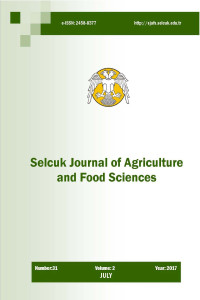Abstract
In some institutions in Turkey, grape breeding programs such as hybridization breeding between superior genotypes of Vitis vinifera L. varieties or clonal selection of local genotypes are carried out. Antique and autochthone grape varieties such as 'Ekşi Kara' (Vitis vinifera L.) are grown since ancient times in Konya-Karaman provinces and middle Taurus Mountains. Its economic value of this variety is high in the production area and is well adapted in the region. It is more indispensable than many other varieties in the region. It is also promising for similar ecologies. The development requirement of this very productive variety has been identified as a need. The flower type of the variety is functional female. A pollinator is a required for a good fruit set. Another ancient and autochthone grape variety, 'Gök Üzüm', is used as a pollen source in the region. Clusters and berry sizes the 'Ekşi Kara' variety in the producer vineyards are closely related to hens and chicken berry development percentage, berry growth, weather conditions (precipitation) during flowering and / or pollination period due to the honey bee activity. This research was carried out under the producer vineyards conditions in which selected in the clone candidates (CC) were identified by the 'Ekşi Kara' grape variety clone selection project of the Selçuk University Faculty of Agriculture, Department of Horticulture and the laboratory conditions. Fertilization biology of 220 selected head CC were examined. The purpose of the study was to search the existence of self-fertile clones among the head CC. For this purpose, the head CC were self-pollinated in covered clusters, freely pollinated with ‘Gök Üzüm’ grape variety and pollens were tested for viability, pollen germination and tube growth of the germinated pollens. All of the head CC did not have any seeded fruit set in the covered flower clusters. Pollen grains were alive in different percentage but in laboratory conditions in all of the tested pollens germination was practically less than 3%. A self-fertile clone candidate has not been identified. Honey bees and some other pollinator insects were the main vectors for pollen transport from 'Gök Üzüm' to ‘Ekşi Kara’. The development of ampelographic and genetic databases will greatly contribute to genetic stocks that have not yet been evaluated in culturally diverse cultures or collections throughout the country, so that the correct identification of genotypes in general will be increased.
Details
| Primary Language | English |
|---|---|
| Subjects | Horticultural Production |
| Journal Section | Research Article |
| Authors | |
| Publication Date | July 31, 2017 |
| Submission Date | June 19, 2017 |
| Published in Issue | Year 2017 Volume: 31 Issue: 2 |
Cite
Selcuk Agricultural and Food Sciences is licensed under a Creative Commons Attribution-NonCommercial 4.0 International License (CC BY NC).

